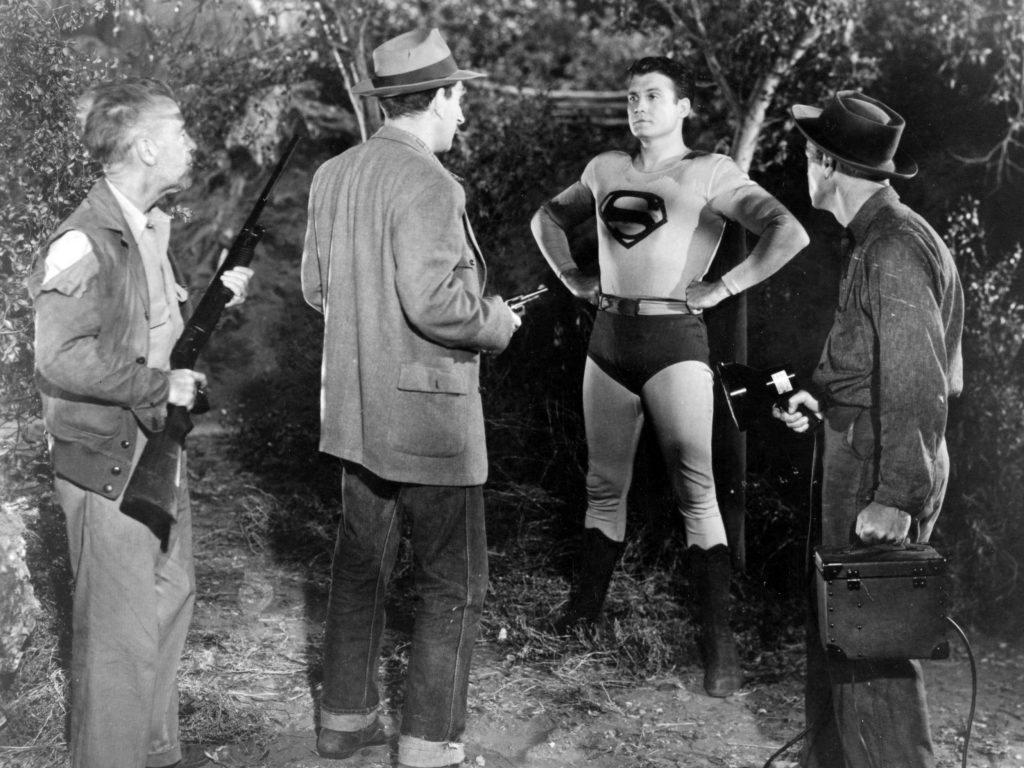Superman’s Curse: The George Reeves Murder-Suicide Was a Hoax
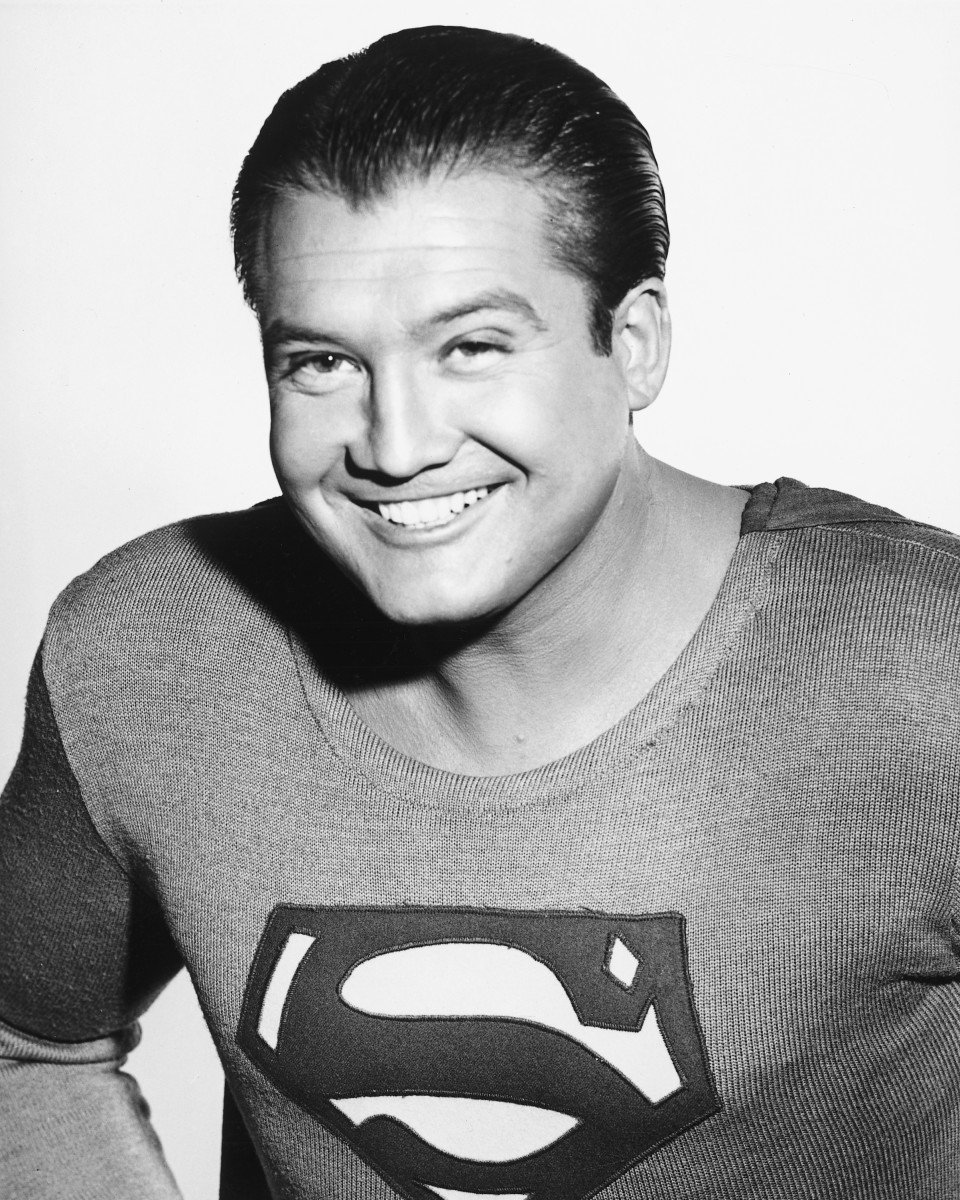
A SHOT rang out.
In the home of actor George Reeves, people frantically handed somebody else their martini glass and then tried to wake the naked couple in bed, though the police wouldn’t be called for nearly an hour. Earlier that evening, Reeves and his fiancée had gotten into an argument at a restaurant or two and, despite planning to wed in only four days’ time, Reeves reportedly wanted out of the arrangement. Dodged that bullet. Too soon?
Within the matter of hours, the Superman actor would be reported dead. It was perhaps the biggest news story of the year in the schoolyard and the sandbox. For the following sixty plus years, the evening plays out like a game of CLUE whodunit, precisely as it was designed to. Ask any room for a show of hands and there will likely be a split decision between George Reeves being the victim of murder and the other half claiming suicide. But as you’ve hopefully deduced by now, I’m claiming neither. Go ahead. Pick your favored scenario. The murder-suicide of George Reeves was a hoax. From what I’ve been able to gather on the Intel-net, I’m the first to make the claim—which is surprising. How is it that nobody else has put the two and two together? George Reeves was simply cast into his latest movie. You likely already know its title. The Curse of Superman.
If you’re new around here and prone to have a hissy fit at the mere suggestion that Reeves flying out of his bedroom window on wires is more believable than the official narrative, just know this isn’t my first throw down in the ring. Eventually, you sit in the audience of the magic show and strain your eyes long enough to catch the Wizard’s sleight of hand. Afterwards, you’ll never be fooled by the same trick again. But that is only if you choose to see it. Most wont. Our Slave Masters know that people show up at the magic show because they want to be fooled. Try standing up during the middle of the performance and flailing your arms back and forth in order to warn the crowd of their deception. I’ve looked into the abyss and I know what I’m dealing with. The abyss has heavy-set eyes. It stares back.
But look at me—getting all dark and ominous with you. Why are we talking about the abyss when the murder-suicide hoax of George Reeves needs tended to? As we should expect with a Hollywood hoax production, it was one of the sloppiest investigations ever. How sloppy was it—you ask. No photos of the crime scene have ever been found. The gun was never checked for fingerprints. Reeves body was embalmed before the autopsy was performed. And the police threw his blood-stained sheets in the washer. We are told it was performed in the manner that it was in order for Hollywood Execs to protect their celebrities. That’s certainly one way to put it. Oh, George Reeves needed protected, alright. He needed to go unidentified all the way to retirement.
Your probable first thought is why they would do something like that. Only pretend to kill the Man of Steel, that is. It’s questions like that which help me to identify who’s the new person around here. Rookie mistake. But that’s okay. For past, present, and future discussions, you’ll want to become familiar with the word Psychodrama. Say it with me. Psychodrama. Again. Psychodrama. Anyone intimate with my work will gladly tell you that psychodrama is real magic. Not the fake stuff they sell you in Shakespearean plays. Except the irony here is that it’s strictly reserved to the world stage. You may have heard of “performance witchcraft” before. Same thing. That’s what a psychodrama essentially is. You are told something terrible happened by your handlers and now you are expected to survive the outcome, or in the very least grapple with its implications. That’s how the alchemy does its work. The catch being that you are sold on an illusion. The illusion itself, as the stage performance suggests, is key to the casting of the spell.
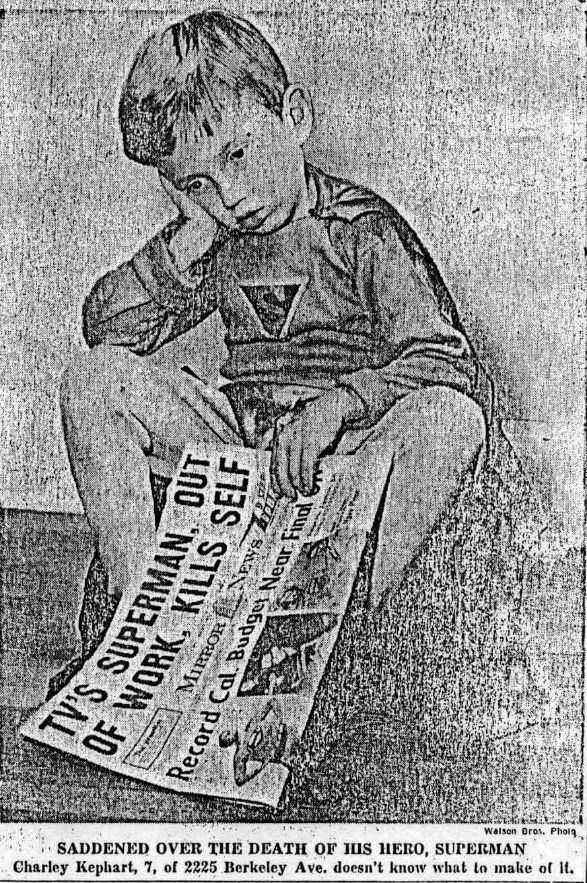
Case in point, the Zionist media had just devoted an entire decade to convincing millions of baby boomer children that Superman was faster than a speeding bullet. On the morning of June 16, they woke up to learn that he’d chosen a bullet of all things to end it. You figure taking a plunge off the Colorado Street Bridge was probably another discussed scenario, as he would have failed to stick the landing after the latest flying segment. Here we see a devastated child identified as a certain Charley Kephart, age 7, of 2225 Berkeley Avenue. You can easily find the house on a map. It’s just blocks away from Elysian Park and Dodger’s Stadium. Just look at that newspaper headline. TV’S SUPERMAN OUT OF WORK, KILLS SELF. Psychodrama. Don’t believe everything you read in ink, kid.
Why would newspapers run the story that George Reeves was out of work? That’s fake news. The tabloids were fully aware that The Adventures of Superman had been picked up for another entire season—maybe even two. At least 26 more episodes. Included in the deal was a proposed tour of Australia and possibly even Japan. That’s how popular that show was. They were so determined to get something off the ground that a spin-off show starring the fictional character Jimmy Olsen, complete with stock footage of Reeves, was considered.
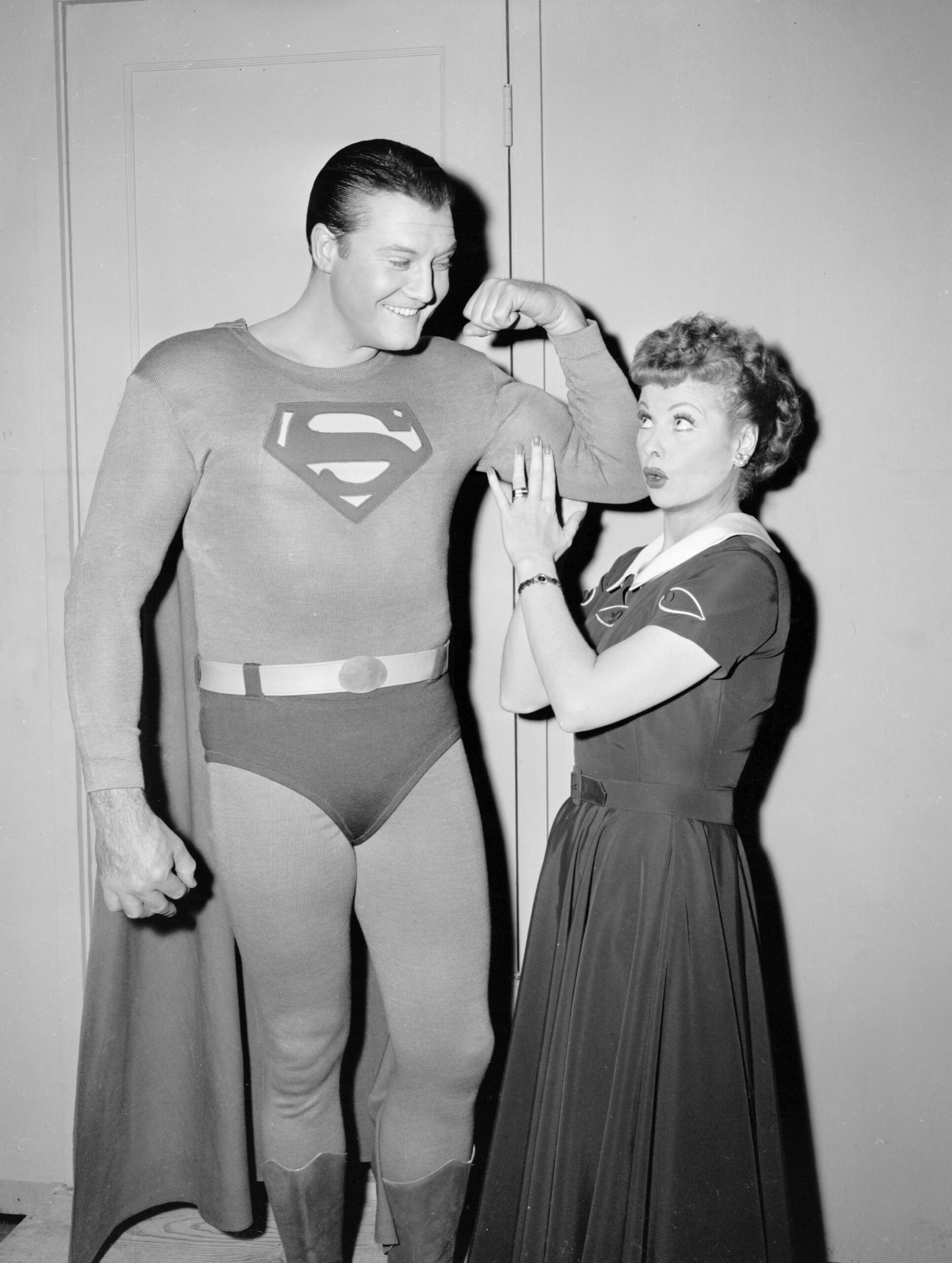
For the remainder of the century, The Adventures of Superman ranked only behind I Love Lucy in syndication. The crew down at Desilu Studios realized they had made a mistake in canceling a good thing and were bringing it back for another run—but even its cancellation and resurgence was probably planned as part of the psyop. The press had already decided on the suicide scenario before the police investigation—as if that’s not suspicious. Children already knew the show was canceled and the media wasn’t interested in lifting the illusion. Notice if you haven’t already, it wasn’t George Reeves who died—but Superman. Sorry kids. Big Daddy was so depressed that he couldn’t be there for you, flying through millions of television sets as your artificial babysitter, that he decided to end it all. Because nobody is going to make Superman bleed his own blood but himself.
You will tell me the reason is that he was weary of being typecast. Sure, let’s go with that. Having more invites than Howdy Doody and Bozo the Clown to every child’s birthday party in America sucks, I suppose. Apparently, a rotunda of women hoping to swoon over him in big red boots and a cape and then do his laundry to, you know, check and see if he was simultaneously the man of stainless-steel underneath, no longer got it up for him—as leaping over tall buildings in a single-bound goes. You think Captain Kangaroo ever had it so good? How did Slim Goodbody ever manage to pull it off? Look, I get it. Playing the Zionist Messiah can become a bore. You figure even the actual Zionist Messiah, once the Illuminati are certain to pull his arrival off beyond the Television, will tire of his role from time to time. Best for Reeves to retire in South America. Kick back a couple of cold ones with Hitler while the aging Fuhrer’s health is still good.
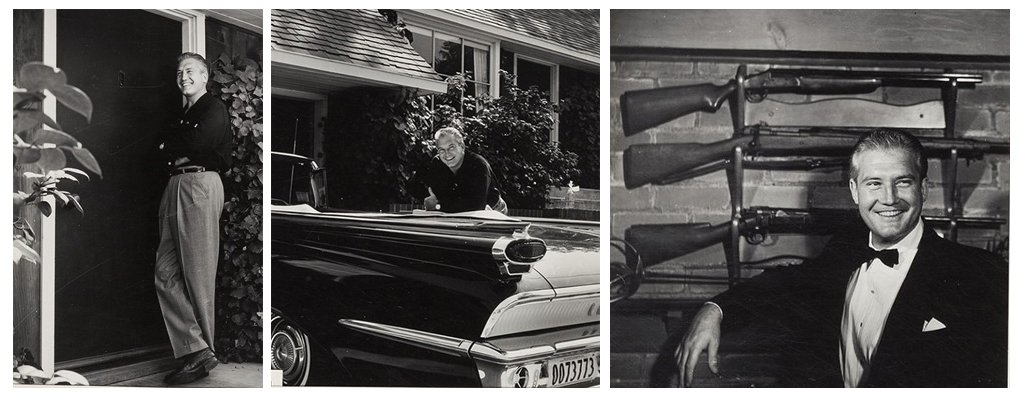
JUST to show us how suicidal he truly was, George Reeves posed for a series of photos within days of his death. How many days before Operation Flappy Cape went live? Less than a week. If you read my series of papers on the Manson murder hoax, then you’ll recall that Sharon Tate and Jay Sebring did the very thing. Here we see George hanging out front of his 1579 Benedict Canyon home. Good looking door, if ever I’ve seen one. Standing exactly as we’d expect of a happy man, I suppose, whenever entering and leaving the very home that had already been bought and paid for by the wife of an MGM film studio executive and producer. But we’ll get to that in a few.
An even happier photo was taken on the driveway with his 1959 Oldsmobile. Fresh plates. Look closely, that’s a temporary license. He’d just bought it. They certainly don’t make them like they used to. Your father’s Oldsmobile probably never looked that good either. Yeah, that’s a man who was going places in style. Not suicidal. Going where, exactly? How about Desilu Studios and another 26 episodes, for starters.
The happiest photo of all has George proudly showing off his gun collection inside the home. Apparently, the black button-up shirt and gray slacks were too casual for a depressed and out of work actor, as he’s committed to a costume change. Same photo session though.
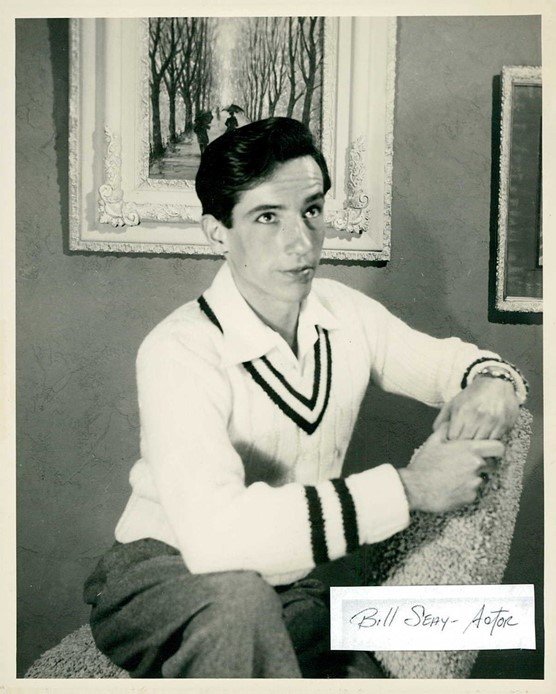
I might as well point out that George Reeves’ last photo-session was taken by this guy. Among other films, Billy Seay was a former child actor who had appeared in Our Gang, before it became known as the Little Rascals. Not exactly a bombshell bread crumb, but he was still an actor. The Hollywood gears were in motion while Reeves leaned over his Oldsmobile to say, Cheese, and Seay was standing on the set. Therefore, I’m putting this out there because you never really know. If Billy Seay was indeed in the know and not just hired on the go, then we’re likely to run into the former child actor at some other psyop.
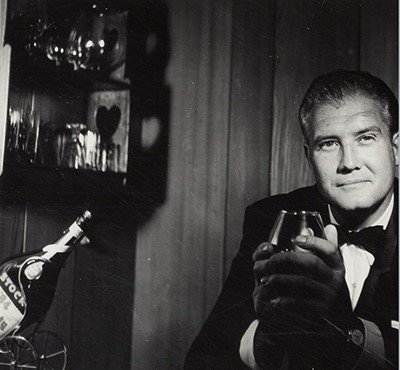
And now we turn to a happy photo of a proud and happy man drinking his beloved Brandy. The gentleman’s baby bottle. Its label reads Stock 84. Not too shabby. Still part of the Billy Seay photo session. Suicide is looking less and less likely of an option, ain’t it? A man doesn’t show off his girls’ guns like that only to routinely guide the cold barrel of a stashed Luger towards his forehead. And besides, you’d think a bullet through the mouth is the surer way to end it.
Hollywood actor Jim Beaver has been talking up his George Reeves biography for some time now. Still unpublished, as of this writing. Apparently, he talked to one witness who claimed that Reeves would get so sloshed at home parties that he’d shoot men’s hats off. Oh dear. Did he first make them stand in front of a hay stack and target or are we expected to believe the walls somehow managed to swallow up the bullet holes? Where’s a tabloid reporter when you really need him? That’s just conveniently placed misinformation to paint Reeves in the strokes of an irresponsible gun owner and open up the suicide option. Art Weissman was Reeves personal assistant. He later told Geraldo Rivera (I know) that George “was not a believer in live ammunition in those guns in the house—because there had been parties in the house before and he didn’t like the idea of anybody picking up a gun and saying bang. And so, the fact that there was live ammunition in one of the guns is a problem for me to accept.” So, it was murder then—you will tell me. No, it wasn’t. Art Weissman maybe insinuating murder, but Reeves’ inner circle of friends are only divided in opinion down the middle because the narrative was set up for both options.
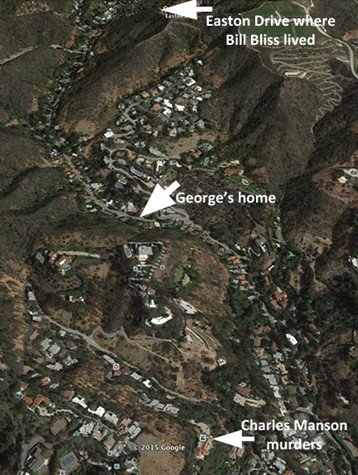
What are the chances that George Reeves lived just down the street from the 10500 Cielo Drive home? That’s where the Sharon Tate murder was staged in as little as a decade. Nope, not a coincidence. From there, the Lookout Mountain U.S. Air Force Movie Studio, where the atomic bomb footage was produced, was just a hop and a skip away. Make a note of Bill Bliss’ residence a little further up the lane. We might as well call this birds-eye view of the earth ‘Spook Street’. When you learn more about the person—or rather the people—who provided Reeves his living accommodations, you too will see that his murder-suicide was yet another Intel operation, like the Manson’s, and that it had long been planned.
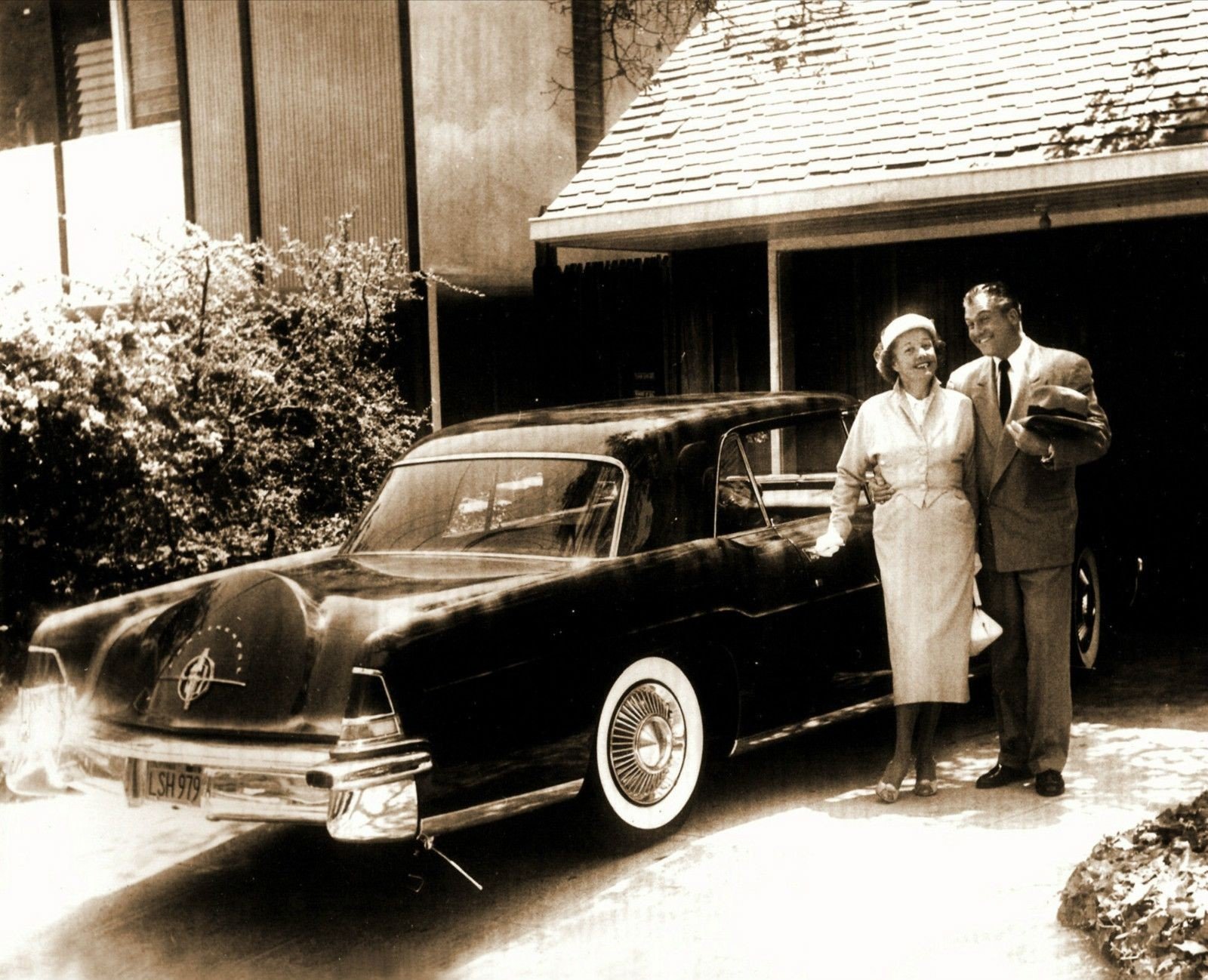
ON second thought, why delay the inevitable? The woman who paid for the house at 1579 Benedict Canyon Drive and then allowed George Reeves to move on in—free of rent—was Toni Mannix. She was born Camille Bernice Froomess, but then became a Ziegfeld Follies showgirl under the alias Toni Lanier. You will recall that Lucille Ball attempted to make the cut as a Ziegfeld girl but, according to the official narrative, was fired in 1932 at the age of 16. Sometime in the 1930s and while still a Ziegfeld girl, Lanier became the mistress of MGM’s general manager, Eddie Mannix. Ah, our next clue. She finally took on the name Mannix, but not until their marriage in 1951, well over a decade later.
Her 10-year affair with George Reeves began in 1948, some three years before putting a ring on it. Over the course of the following decade, she would shower Reeves with expensive gifts. Eddie Mannix clearly didn’t mind, as he not only consented to her boy toys and the necessary toys for those play things, but according to The Guardian, “He and his own mistresses often went on double dates with George and Toni, and when they traveled it was Mannix’s in first-class, sexual playthings in coach.”
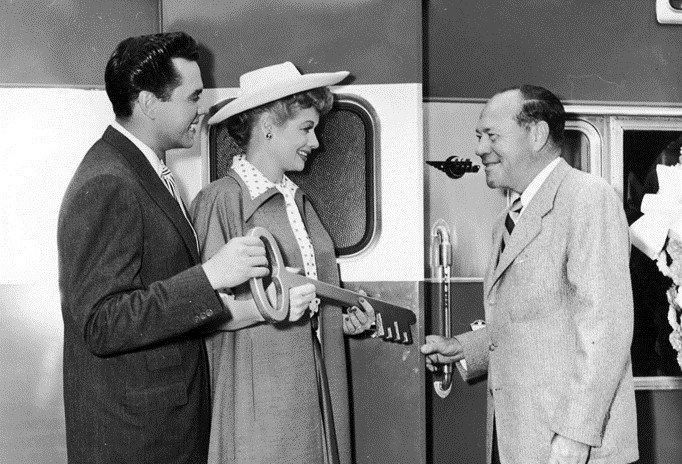
Eddie Mannix. There he is. Yes indeed, Eddie Mannix. Presenting Desilu with a key. A giant key. What sort of door might that key open? We are not told. Probably congratulating them on their televised alchemy, from one Ziegfeld handler to another. I suppose that would be depressing, banging the wife of a Hollywood Executive while he approves and never getting cast into any of his MGM movies. Wink-wink. How anyone is incapable of seeing that Reeves was being groomed for The Big Day is beyond me. Eddie Mannix, you see, wasn’t simply a producer. The man from Jersey was a Hollywood fixer.
I bet you didn’t know that MGM had its very own “Special Services Department.” Well, it did. As head of the public image publicity wing of the filmmaking industry, Mannix was paid to disguise details of the colorful private lives which contracted luminaries often flaunted indiscriminately. Sounds like thinly disguised Intel work to me, but that’s probably none of my business. Officially though, when a star was in trouble, they knew who to call. It was Eddie Mannix who took care of them. Solved their problems. Told them what they could and could not say to the press. Hid their crimes. You know, the Big Boy stuff that went beyond the expertise of their usual day-to-day handler.
Remember when Paul Byrne, husband of MGM’s biggest star, Gene Harlow, was murdered? Mannix was on top of it. Judy Garland’s drug addictions. Not a problem. The murder of Ted Healy, creator of The Three Stooges. On it. An unmarried Loretta Young is found with child and a married Clark Gable is the father? Call Mannix. He’ll have the press convincing everyone that Young is simply adopting someone else’s kid. So clever of him. The Wikipedia sums up Mannix as follows:
“During his career at MGM Mannix apparently also left a trail of forced abortions, sham marriages and several other unsolved murders in his wake”
Oh dear. Are you telling me there were fake marriages in Hollywood and the television and media said otherwise? Say it ain’t so. In order to pull off the illusion, Mannix would need a complex web of contacts at his constant disposal, and from every arena. There was of course the constant butt kissing to Louis B. Mayer, but then consider the reporters and doctors, as well as politicians and the police needed for his day-to-day projects. Mm-hmm, Intel. Why do I get the feeling that Mannix could just as easily create scandal? You know, like those “unsolved murders.” Make somebody “go away” for the purposes of “public image.” This week it’s a car wreck. Last month it was a plane crash. Just tell them he took a bullet to the skull and let everybody grovel for a cause. Murder or suicide? That’s the fun part, as they’ll never even think to question the bullet. It’s a psychodrama thing.
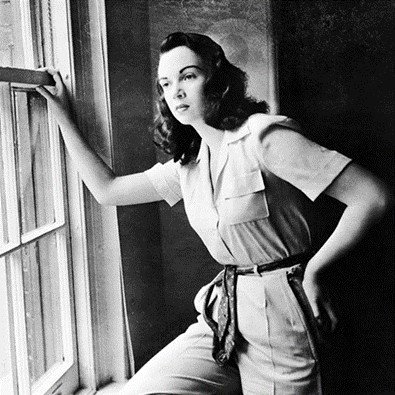
THE Yoko Ono of this story is New York socialite Leonore Lemmon. She is described to us as a reputed gold digger with a volatile temper; a playgirl who was at one time infamous in New York as the only woman ever tossed out of the Stork Club for fist-fighting. Also, an actress. Before meeting George, she was married to a Vanderbilt. Specifically, Vanderbilt heir J. Vanderbilt Webb. We’ve already taken a look at the Vanderbilt courtroom drama in my Shirley Temple paper and the conclusion is a unanimous one. The Vanderbilt’s were spooks.
Upon their meeting in 1958, George Reeves apparently took a liking to her, as he promptly dumped Toni Mannix. Poor girl. The nerve of Reeves. After buying him a house and everything. She must have been crushed. Devastated, I tell you. Reeves inside circle of friends would later recount how he enthusiastically claimed Lemmon made him feel young again, despite observations that the couple had a tumultuous relationship, arguing frequently. Probably no manipulation there.
The picture being formed for us is that Reeves was a fool for letting a New York girl with obvious mob connections get the better of him. That’s adorable and all, but Lemmon was likely arranged by Mr. and Mrs. Mannix from the very beginning. All we’re witnessing here is the trade off from one handler to another. We’ll just call Lemmon another boy-toy gift, the only difference here is that Mannix needed to cover her tracks and let somebody else get the publicity while a certain fixer did the heavy lifting.
Fun fact. Reeves and Lemmon met at Toots Shor’s Restaurant at 51 West 51st Street in New York City. Why that little detail is so often repeated probably has something to do with the person Toots Shor. He was an Ashkenazi Jew whom The Wikipedia claims was a “confidant to some of New York’s biggest celebrities during that era,” including Chief Justice and 33-Degree Freemason Earl Warren, whom Toots considered to be one of his “closest friends.” You know, the same Warren who led the Warren Commission. Oh, the tangled web we weave. In conclusion, Toots Shor was unimportant and probably a nobody.
Included in George Reeves love-struck delirium is the fact that he and Lemmon were engaged soon after their “meeting.” Adding insult to injury, Lemmon quickly moved into the very house that Mannix had purchased for him. We are then told how Mannix was so devastated by the recent turn of events that Reeves had to file for a restraining order. Oh dear. Blame the fact that I’ve pulled back too many curtains, but that’s exactly the sort of thing that a slave might do to defeat their handler. Or in Emperor Palpatine terms: “Everything that has transpired has done so according to my design.” Bwa-ha-ha.
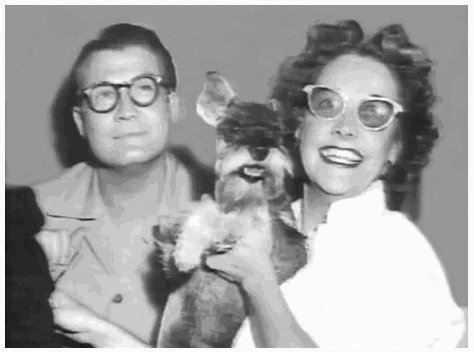
According to The Unredacted, “Reeves himself was convinced it was Mannix behind a string of strange incidents that had befallen him in the aftermath of their breakup. He was inundated with menacing silent phone calls at all hours of the morning and someone even abducted his beloved dog, Sam.” Um, yeah. If it walks like somebody’s handler, and makes phone calls like somebody’s handler, and then kidnaps dogs like somebody’s handler. In other news, Reeves was injured in a car accident some two months prior to his run-in with the bullet. His mechanic reported that the brake lines had been cut. Still writing Superman scripts, are we—hmmm?
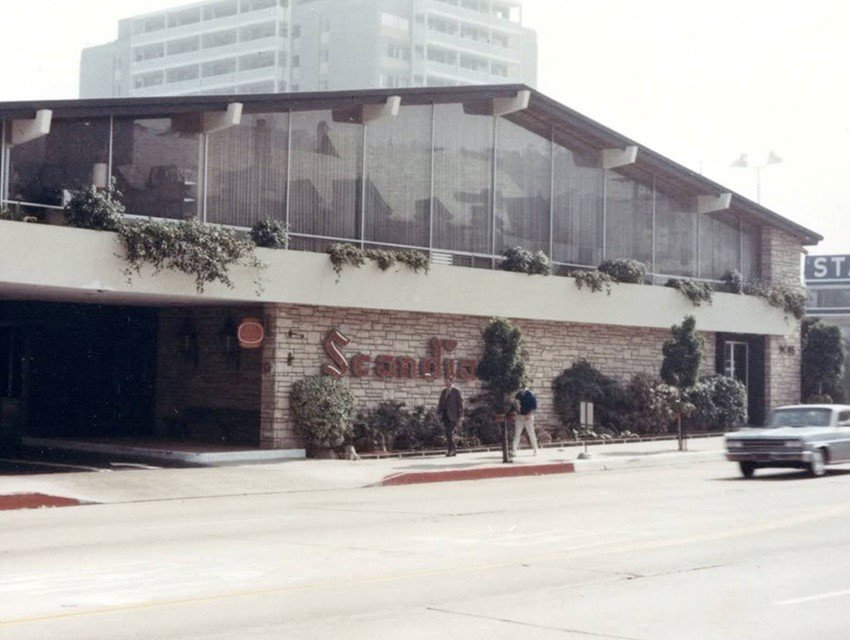
HIS last meal was at the Scandia Restaurant, which was at one time located at the corner of Sunset Boulevard and Doheny Avenue. Actually, George Reeves had two last meals on the evening of June 15, as he later arrived at Paul’s Steak House, then existing on the corners of Burton Way and Doheney Drive. Are we expected to believe that Scandia left George Reeves with an unfulfilled appetite? Scandia is described to us as an “extravagant global cuisine spot.” Hope those small global portions didn’t cost him much. Multiple takes from the same movie, I guess. Couldn’t decide on which meal to go with for the final edit.
Reeves and Lemmon were apparently scheduled to marry on June 19, only four days away, with a honeymoon afterwards in Tijuana. At both locations they were witnesses who hear them arguing about it. We are often told Reeves was calling the whole thing off. Must be murder then—but by whom? So many women scorned. Perhaps Reeves was simply telling his handler that she wasn’t allowed to follow him into retirement after their invite only suicide-murder party, who really knows? Then again, Tijuana may have simply been a code word for another meeting point entirely. Really, if you’ve been following, it’s complicated.
Somebody named Merrill Sparks was the piano player at Paul’s. He later recalled seeing George and Leonore arriving for dinner, and that afterwards, Leonore was “chatting it up” with various people and getting free drinks in return. George sat alone at the piano bar, listening to Sparks’ finger-work. Accordingly, Reeves was “completely composed and immaculately dressed and in a retrospective mood while Leonore entertained the bar patrons.” Probably quietly contemplating his future in Argentina. Space is fake, but given that fictional scenario, if I were an astronaut and this was my last night on planet earth, I’d probably do the same thing. Find a piano player and a glass of brandy and stare off into a blank wall while my handler “entertained the guests.” Good times.
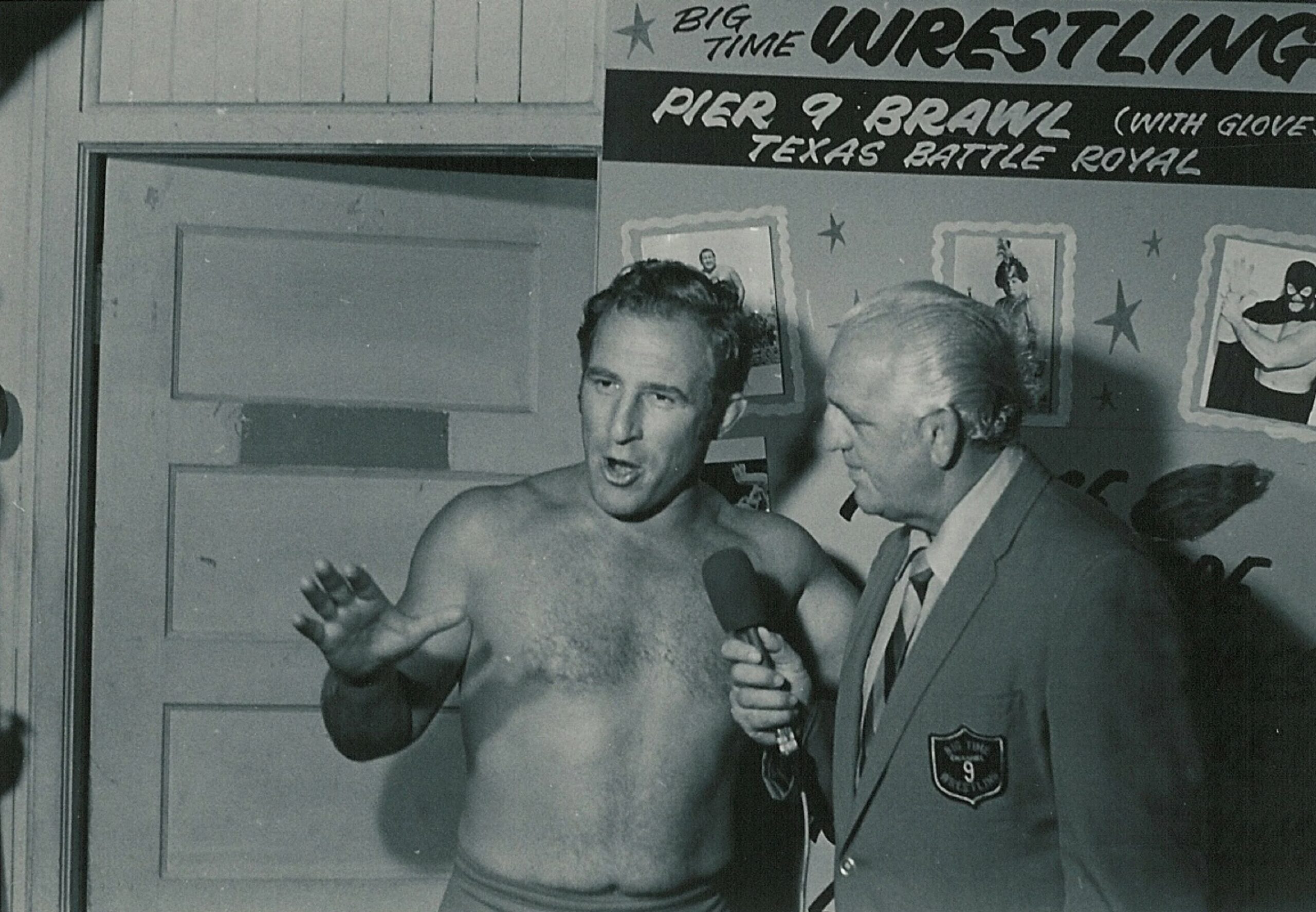
It was during Sparks’ break—he figured around 9:30 pm—that he observed Reeves and Lemmon waiting out front for their car. Arguing. How he could have possibly honed in to such intimate details, such as Lemmon insisting that she get hitched in Baja, only seems to infer that the two were going out of their way to make their little backstory known.
“Hey everybody, we’re arguing! We’re going to get married on June 19, only four days from now. In another country. We’re leaving. And we’re in disharmony over that decision! It would be a total shame if something bad happened between tonight and then!”
Ah, now I see. Making your backstory known at only one restaurant isn’t a very good insurance policy—as alibis go. Better make it two.
They were then observed leaving Paul’s together, but where to—more food salvaging? No, just wrestling. Lemmon stated in interviews with Beaver that they attended a wresting match involving Reeve’s friend, Gene LeBell. The Wikipedia lists LeBell as an actor who appeared in 1,000 films and television shows. I would say this was one of them, but LeBell never had any recollections of having seen Reeves after their workout session earlier that day. Oops. Reeves’ agent neglected to hand the script off to LeBell’s agent. Meanwhile, the unhappy couple drove off somewhere other than home. Must have had a last-minute meeting with their booking agent. I get it. Can’t blame them. Tensions were high. When it comes to these murder mysteries, you only get so many takes.
THE STORY goes that George Reeves and Leonore Lemmon finally returned to their 1579 Benedict Canyon Drive home after a “wrestling match,” or someplace else entirely never made known to us (probably unimportant), and that Reeves retired alone for the evening—needing his beauty sleep. Somebody named Robert Condon was staying as a houseguest, and so too decided to retire in his room. Condon was a ghost writer, currently taking the autobiography of prizefighter Archie Moore to the typewriter. How good of a ghost writer was he? I can’t find a single picture of him on the Intel-net. Can’t claim him to be undedicated, that’s for sure.
As a semi-regular restaurant patron, I wouldn’t know the first thing about spotting a ghost writer in the room. Condon however had been witnessed earlier that evening restaurant hoping with the couple. “Oh look, its Superman with Bobby Condon, the ghost writer!” Reeves was an experienced actor and knew a thing or two about having the people from the writer’s room handy, in case of last-minute re-writes. Lemmon decided to just hang around in the living room while the two boys retired separately, I guess. Perhaps waiting for someone to walk through the front door, who really knows?
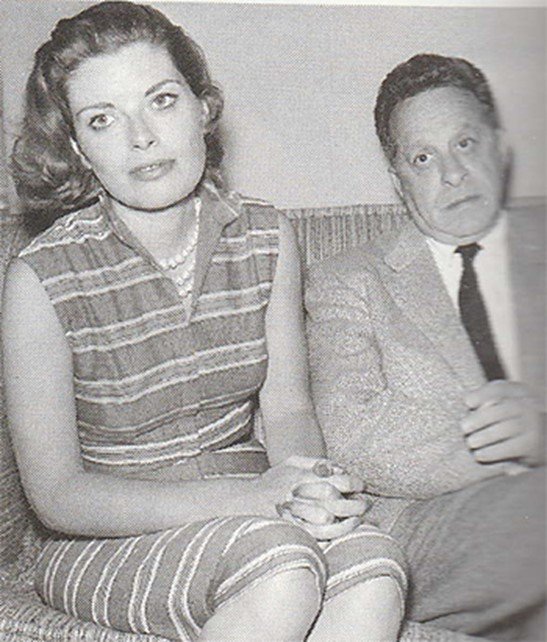
Somebody did happen to walk through the front door. 33-year-old Carol Van Ronkel of 2300 Benedict Canyon Drive showed up on the front porch at 1 a.m. wearing only a nightgown. So, your basic late night in the Hollywood hills then. Van Ronkel was the happy wife of another Hollywood scriptwriter—a certain Alford Van Ronkel. His scriptwriting credits include Destination Moon and Destination Space, so you know those two were in deep. We are told Van Ronkel arrived hoping to disrupt Condon from his nighty-night regimen and that her husband was left unaware, but that it was no big deal because she “lived in the neighborhood.” There’s an old saying in my household that if you the wife want to grab the man’s attention, be sure to stand naked in front of the television while the golf tournament is on. That usually works 11 out of 10 times. I’m sure Alford didn’t notice in the least that his wife was taking their dog or whatever on a walk through the dark canyon in her undies while he remained behind at the typewriter fleshing out his latest NASA propaganda piece. Sometimes we just have to go with these things, and this is one such occasion.
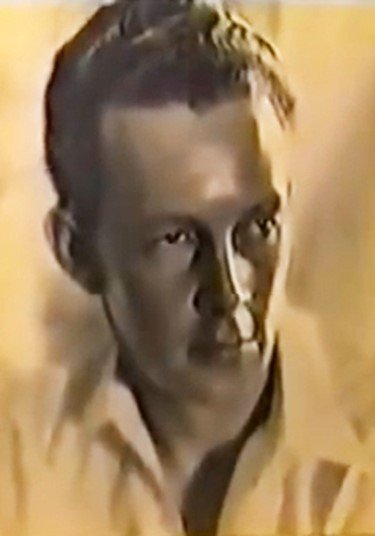
Then again, Van Ronkel wasn’t the only person to conveniently show up moments before the gunshot heard around the world. Somebody named William Bliss was driving down the street when he noticed that Reeves’ porch light was on and decided to ring the doorbell, hoping to P-A-R-T-Y. Sure, let’s go with that and pretend like Reeves never turned his porch light on during any other night of the week. Nobody even knew who this guy was. Not even George Reeves. So very nice of Lemmon to let a stranger into their house then. For the record, you are apparently looking at the only known photograph of Bliss. So mysterious. His friends called him Bill though. Is he an employee with Lookout Mountain or some other Government agency? We’ll apparently never know, will we—as the police never thought to include a key witness in their investigation.
Now that our agents are all in place, we are told that Reeves came downstairs, agitated at the noise from his late-night callers, and in no mood for a party. Because you know, Bill Bliss was a wild and crazy guy, apparently. The date was June 16, and the time read 1:20. We are told everyone at the get together was already sloshed, and that they were too incoherent to make statements to the buttons, but they must have arrived drunk then, as they’d only been drinking George’s booze for twenty minutes or less. Must have been guzzling the bourbon. Reeves threatened to throw Bliss out, but eventually both apologized, shared a drink, and then parted as best buddies.
“He’s going upstairs to shoot himself,” Lemmon told the other three.
A noise was almost immediately thereafter heard in Reeves’ room, in which Lemmon added, “See, he’s opening the drawer to get the gun.” Then a shot rang out and Miss Lemmon exclaimed, “See there, I told you. He’s shot himself.”
What the huh…?
From this point onward, the story fractures into several parallel dimensions, depending upon who is telling it. We hear about Lemmon, Condon, Bliss, and Van Ronkel all inhabiting the same room at the time of the incident, and yet Condon and Van Ronkel somehow end up naked in bed together, needing rescued. Bill Bliss later told Milicent Trent that he was helping himself to the booze when Leonore Lemmon came running downstairs, seconds after the shot rang out, and exclaimed: “Tell them I was down here! Tell them I was down here!”
Who is Milicent Trent and why would Bliss be speaking with her about somebody else’s death? I’m glad you asked. Milicent Trent knew a thing or two about “suicide.”
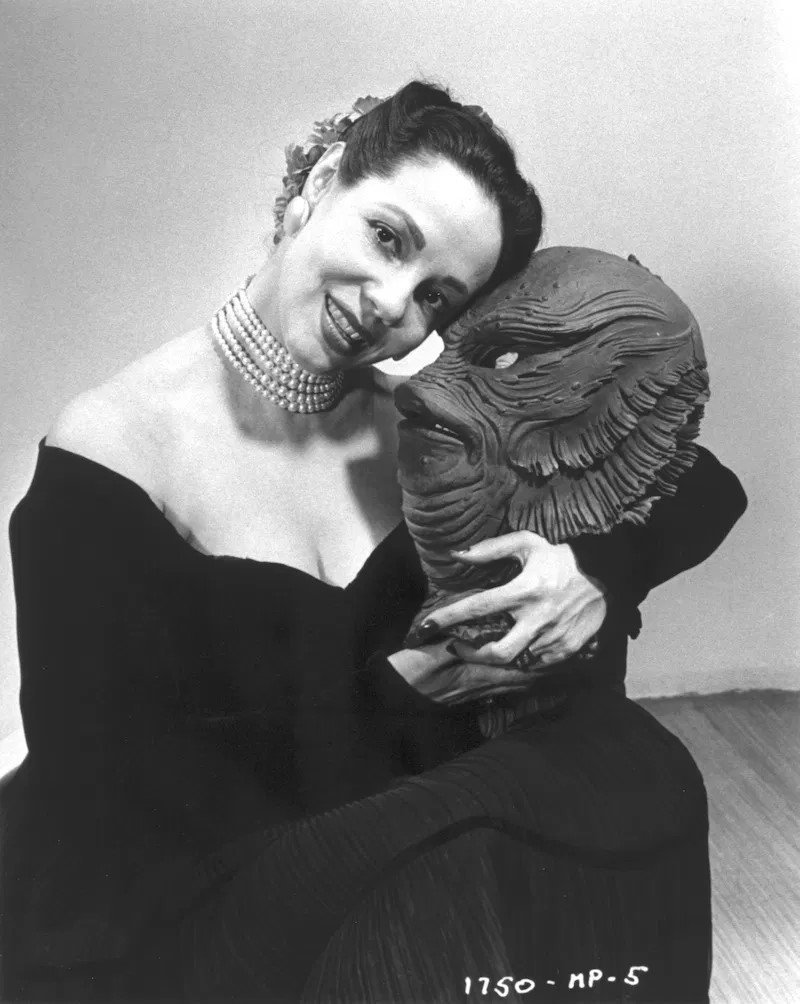
Milicent Patrick, born Mildred Elizabeth Fulvia di Rossi (finally becoming a Trent through marriage), was a Disney animator and a Hollywood costume designer, her most notable work being the iconic Gill-man costume for Creature from the Black Lagoon. Other special effects and makeup work of hers includes It Came from Outer Space, Abbott and Costello Meet Dr. Jekyll and Mr. Hyde, and The Mole People. But long before that, her father was superintendent of construction at Hearst Castle in San Simeon. In fact, The Wikipedia has Milicent Trent growing close with Hearst’s wife, Millicent Hearst. Confused as to why they’re both named Milicent? I am too. The only difference in spelling is that Hearst’s wife is given two l’s rather than one. All we are told is that Millicent Hearst inspired the name change. Intel knows I like to read their articles. The Wiki is dropping a challenge and leaving me to ponder over the implications.
The Wikipedia seeks to further antagonize me by stating that she met her first husband, Paul Fitzpatrick, while working at Walt Disney Studios. It then reads: “Fitzpatrick was married, and they began an affair that was discovered by Fitzpatrick’s wife, who later committed suicide when Fitzpatrick refused to stop seeing Rossi.” Fitzpatrick was free to remarry. Milicent was given another name change. Mil Fitzpatrick. They then divorced. The next name change saw her as Milicent Patrick, in which she had a relationship with voice actor Frank L. Graham in 1950 but soon thereafter killed it. “Several weeks after she ended their relationship, Graham killed himself at his home.”
There is a point to this little exercise. At least somebody can vouch for the existence of George Glass Bill Bliss, and that person is the woman with a penchant for suicidal relationships and a dozen different name variations—her favorite being a Hearst.
BUT back to the murder-suicide paradox. The Bill Bliss version has Leonore Lemmon going upstairs at 1:30 to retrieve his Luger from the bed drawer while George was occupied in the shower. When George entered the room, he wrestled for his life, but she still managed to plonk a couple of rounds off into the floor. Nobody heard those two. The third, which Bill Bliss but the naked couple failed to hear, did him in. One spin-off timeline sees Lemmon capable of climbing out the bedroom window and returning into the house through some other door, so as to convince everyone present that she wasn’t up there. Or are we in the other parallel dimension whereas Lemmon cracks a series of jokes about her fiancée killing himself?
Yet another version has Bill Bliss waiting for his opportune moment. After shooting Reeves with a single shot to the head, he escapes out the upstairs window and back into the house without anybody else noticing. There is yet another variation which has an unknown assailant and associate of Bliss sneak in the back while Bliss occupied the others. That’s probably it. In either tale, Lemmon waited nearly an hour to call the police. She then told investigators she was “only kidding” when she made the remarks about Reeves’ plans to kill himself.
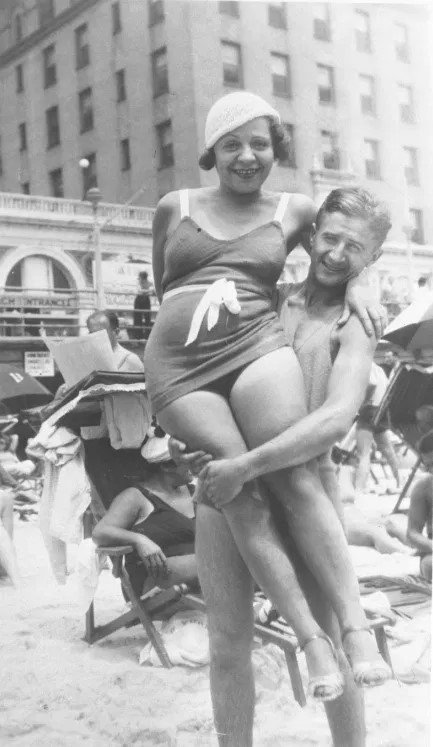
THE next person to arrive at Reeves’ 1579 Benedict Canyon home was Polly Adler, a Russian Jew and infamous bordello owner, who is described for us as a longtime friend of Leonore Lemmon and Robert Condon during their “New York City days.” Must have arrived to see Lemmon’s fiancée off. Wish him luck, that sort of thing. Polly Adler opened her first bordello in 1920 under the protection of Dutch Schultz, a friend of mobster Charles “Lucky” Luciano. So nice of him. If the Copernican Revolution taught me anything, it’s that love makes the world spin round.
Another nice pairing of persons were architects from the firm of Schwartz & Gross, having completed The Majestic at 215 West 75th Street for Polly in 1924. The Majestic was conceived as a brothel, complete with hidden stairways and secret doorways. There are naysayers as to the intent of Schwartz & Gross’ design, claiming that the hidden stairways and secret doorways were in actuality fire escapes, but you and I know better. Funny how they were kept secret and hidden from the police during raids. Had there been an actual fire, the police would have been screwed. Also, you know even the raids are awkwardly staged when clientele includes NYC mayor Jimmy Walker and the New York State Supreme Court justice Joseph Force Carter. I’m sure Walker and Carter simply wanted to appreciate architecture with an added adventure in the case of an emergency. Actually, Carter went missing on August 6, 1930, never to be found again. It is thought that he was admiring the nicely crafted building at 215 West 75th Street, but from within. Must have gotten lost behind the bookshelf.
Further clientele included cartoonist Peter Arno. He contributed 99 covers to The New Yorker from 1925, the magazine’s premiere year, until his death in 1968. His father was Curtis Arnoux Peters, a New York State Supreme Court judge. The founder of The New Yorker was Harold Wallace Ross, and he was a frequent visitor. So was New Yorker columnist and film actor Robert Benchley. George S. Kaufman, visitor. Milton Berle, visitor. John Garfield, visitor. Dorothy Parker was a Rothschild and she was a frequent guest, but then again, even Kaufman, Berle, and Garfield, like Parker, were Joos. We find one more bread crumb trail leading to Desilu Studios with Desi Arnaz, as he was also an admirer of buildings—particularly The Majestic.
It’s like I’ve always said, “If you’re going to make a quick escape, unseen by the buttons, best to call Polly up on the phone.” That’s why Leonore Lemmon called dialed her digits, you know. To get the naked people out. According to Adler, Lemmon said: “You have to get Bobby out of the house. He’s in bed with a friend of mine who’s married!”
You will recall that Bobby and Carole were actively sleeping in the same bed when the gunshot went off, leaving only Bliss and Lemmon in the same room, or simply Bliss by himself, or perhaps even all four of them together, depending on what floats your boat. Long story. Polly soon arrived (being in the neighborhood), as she and her car were reportedly seen at the house that night, but then left before the buttons arrived and without Bobby. She came. She left. Probably unimportant.
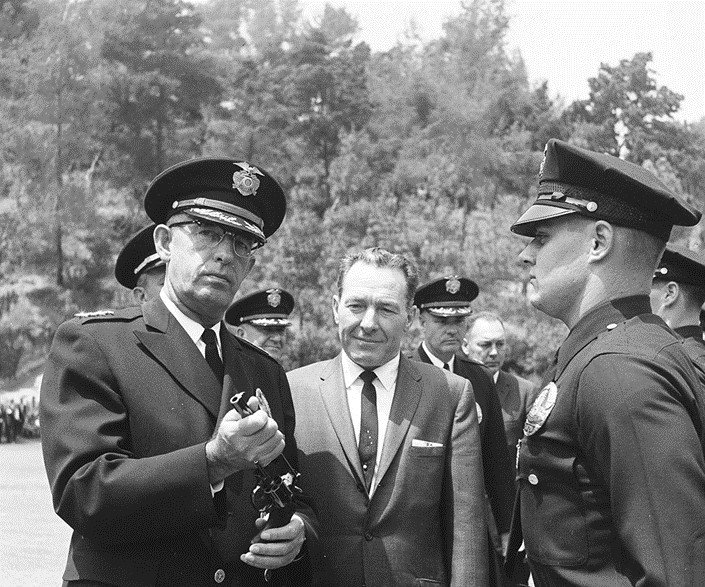
Police Chief William Parker later recalled: “Everyone in the house was very drunk. It was difficult to determine just who all had been in the house that night.” Preach it, brother. You can say that again. Well, he’s not my brother. Somebodies Lodge Brother, likely. Just not my own, as I am not a Freemason. I guess I just got a little overly excited at the confessional. Or did Parker manage a Freudian slip? Either way, we’ve seen this before with the Manson murders when there were 25 fingerprints at the Polanski house and nobody to claim them. That’s a tell-tale sign that the boys down at The Lab are setting up, or in this case, taking down the set. What are the chances that Polly Adler drove off with the man of the hour?
Parker became LAPD Chief some nine years earlier, on August 9, 1950. The Wikipedia credits him with transforming the LAPD into a world-renowned law-enforcement agency, adding: “The department that he took over in 1950 was notoriously corrupt.” You’re probably wondering how he managed to clean it up then. It’s a long broom and dustpan story, but it involves Parker’s partnership with Hollywood and a television show called Dragnet. You might have heard of it. Chief Parker not only promoted the show, but supplied Dragnet creator Jack Webb with access to police files. Parker is also listed as a producer of The Thin Blue Line panel show, which aired weekly on NBC in 1952. I’m sure that’s where their partnership ended though.
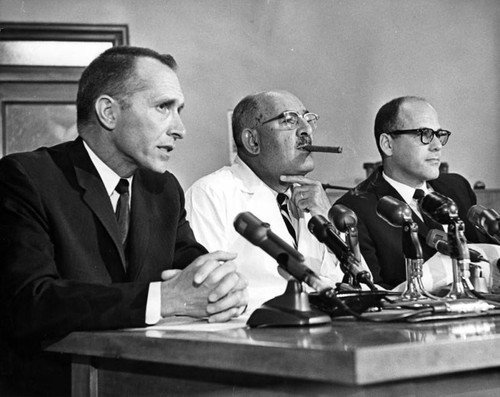
THE GUY smoking the stogey in the straightjacket is Theodore J. Curphey, Reeves’ coroner. Curphey was elected Nassau County medical examiner in December of 1937. That would be Long Island. By 1957, Curphey made the move and became the first Coroner of Los Angeles County. You may want to hold onto something, preferably toilet paper, because Curphey was also the chief coroner for Marilyn Monroe. Don’t say I didn’t warn you. On August 7, 1962, two days after her departure, it is Curphey who announced that a massive overdose of barbiturates was the kiss of death. He later said she had lethal doses of both Nembutal or chloral hydrate and she could have been killed by either, but you and I know better. Marilyn Monroe was a dude.
Following in his footsteps as L.A.’s second Coroner was an even bigger hoaxer. Thomas Noguchi had a hand in the Marilyn Monroe disappearing trick, but then oversaw the autopsies of Albert Dekker, Robert F. Kennedy, Sharon Tate, Janis Joplin, Inger Stevens, Gia Scala, David Janssen, William Holden, Natalie Wood, and John Belushi.
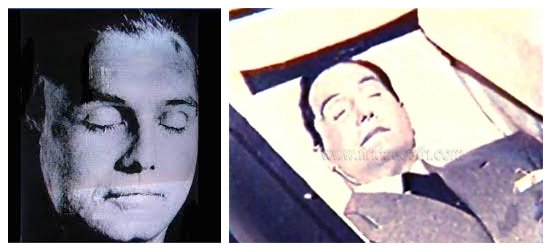
In addition to the awkward fact that Reeves killed himself while a party raged on downstairs and he lay in bed naked, hot and steamy from his shower, Curphey did not think it necessary to perform his autopsy until after the body was washed. But that’s probably unimportant. Being incapable of testing for powder traces on his hand and head wound has nothing to do with his decision, I’m sure. You’d think there would be something of the sort present if they were to judge he had shot himself at close range—but no. Testing a blood-alcohol content of .27 was clearly enough to match up his story with the press. We are only shown one autopsy photo but never an exit wound. They tell us the top of his skull was removed. We’ll have to take their word for it. Looks like they cleaned up his entry wound real-nice for the coffin photoshoot though. He would then be cremated, but not for another few years. Really, Curphey sounds like the perfect candidate for a Coroner—if you need him bought and paid for, that is.
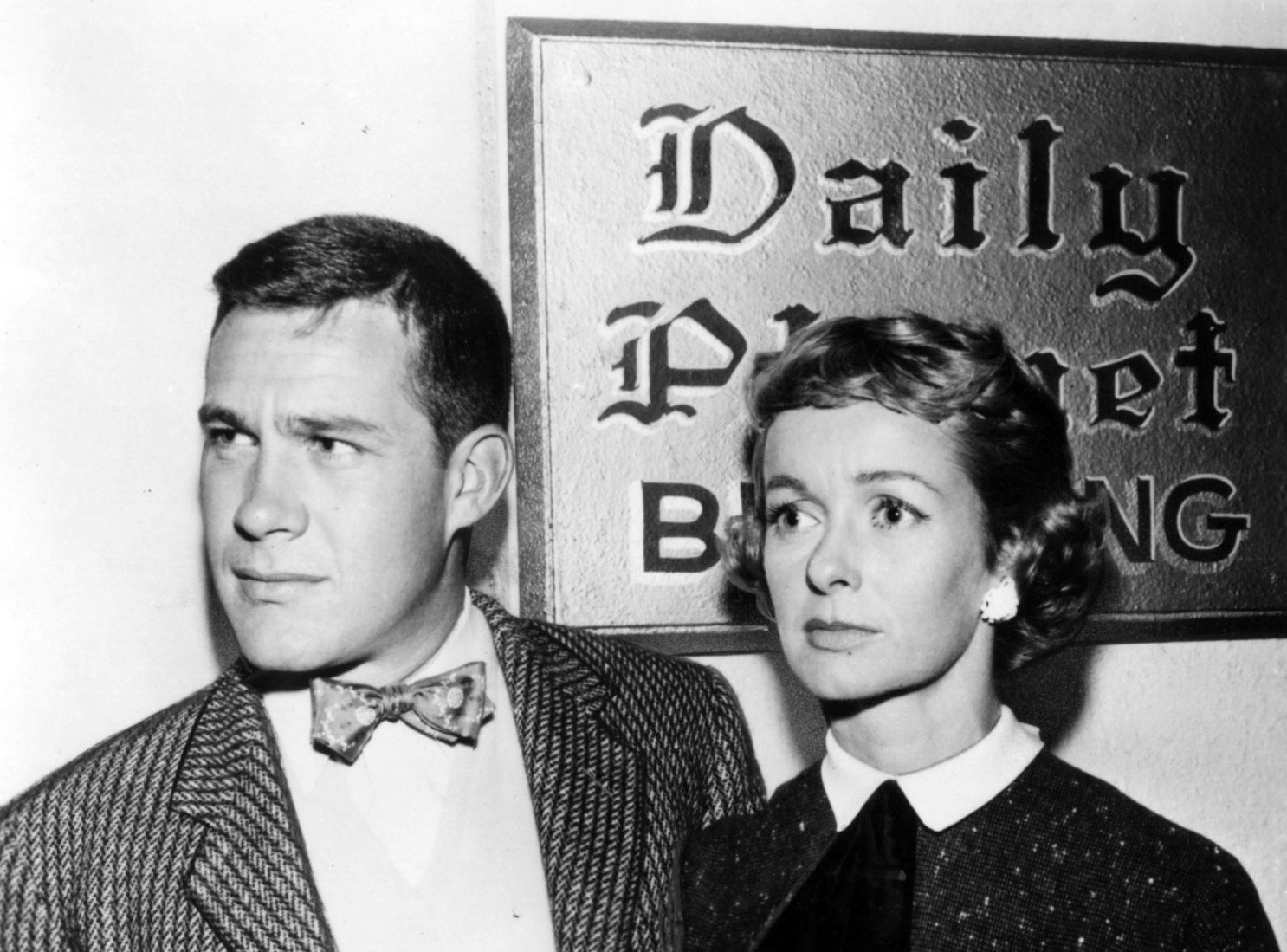
JACK Larson does his best to include himself in the murder-suicide of Superman psyop by placing his whereabouts in the 1579 Benedict Canyon Drive home only a day or two afterwards. Mm-hmm, Jimmy Olson is on the case. The catch here being that Superman’s pal arrived secretly with the old girlfriend, Toni Mannix. Because that’s something which Larson and Mannix did, apparently—they paired up together to solve crimes and stuff.
Upon entering the home, Larson places the bloody sheets in the upper room bathtub, whereas others claimed they’d ended up in the washer. Hmmm, interesting. Tell us more. He then said he turned around and saw Mannix on her hands and knees, investigating two bullet holes in the floor. So, how many bullet holes is that now? The police report has the bullet that killed Reeves lodged in the ceiling, despite Reeves laying on his back with his feet on the floor. Also, the shell was found underneath Reeves body while the pistol was discovered at his feet.
Noel Neill played Lois Lane in the television show, and she claimed there were far more than three bullet holes. “You only hear about the four or five in the floor…” Wait, I thought there were only two. “…but there were many others that were in the walls. I had a friend whose husband was later hired to repair the drywall in George’s bedroom. He said the place was literally riddled with bullet holes.” Well, there’s that then. So many bullet holes. It must have been the Saint Valentine’s Day Massacre up there. Amazing how nobody heard the ruckus. They probably used silencers.

Then again, George Reeves had reason for ending it after all. As a writer and artist for DC Comics and all-around comic book editor, Fredric Whitney Ellsworth had switched producing duties with The Adventures of Superman for a brand-new spin off series called The Adventures of Superpup, which sought to place the Superman mythos into a world populated by pooches. Had the series aired, live-action actors in dog-suites portraying canine versions of Superman and other characters would have weekly viewers howling with laughter. It never aired. Bummer.
LEONORE Lemmon never stuck around for the memorial service. Classy girl. She did however return to the house after the police had left for food and booze. Also, to retrieve the travelers checks which Reeves had written his name upon. Reeves probably just forgot them on his way out. She then left town and returned to New York for good. Perhaps Tijuana was code word for Manhattan after all. Who really knows anymore?
We are told the police never questioned nor asked her to testify because she had ties with Mickey Cohen and had been out on a date or two with Jimmy Hoffa. I know, right? Ridiculous. I’m no police detective, but I would think George Reeves call-girl fiancé having close connections with the Jewish mob would be an excellent reason to find her number in the phone book and ask the hard questions—but no. Mickey Cohen just keeps popping up in these Intel psyops, don’t he? Spooks all seem to swim in the same circles.
YEARS later, gossip columnist Edward Lozzi claimed to have insider’s knowledge about the crime after overhearing Tonie Mannix confess on her deathbed to a priest that Eddie had Reeves killed. Seems legit. It’s like I’ve always said, if you’re going to confess your deepest darkest secrets to a Catholic priest, be sure to bring along the Hollywood gossip columnist.
Noel
